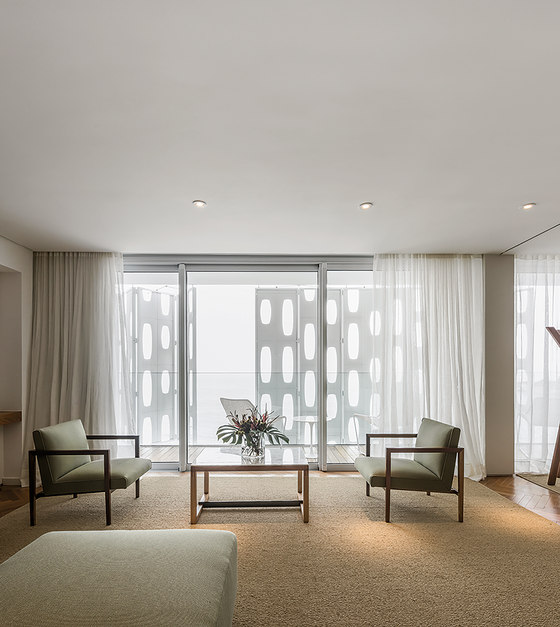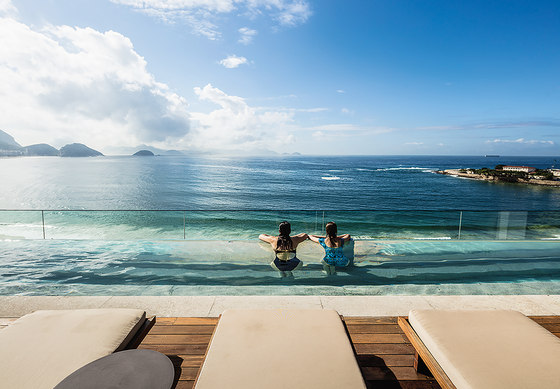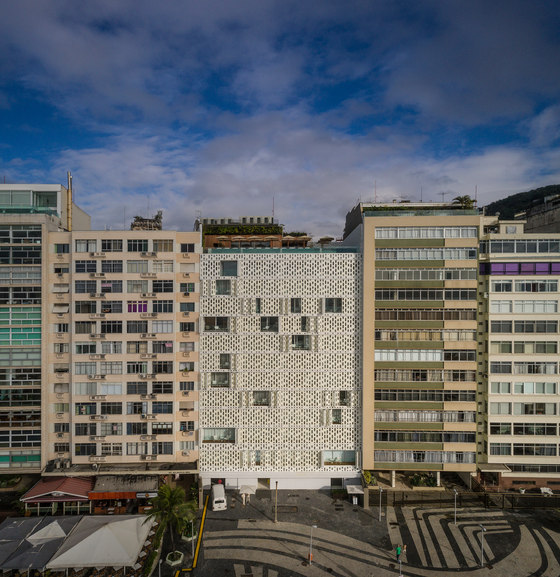The Emiliano hotel arrives at Rio de Janeiro, and like the one from São Paulo, it bares the signature of Studio Arthur Casas – the preliminary framework of the project has co-authoring of the American architect Chad Oppenheim.
The contemporary architecture of the building, located in front of Copacabana beach, gives priority to natural light, valorizes the view and connects the guests to the Marvelous city. To meet the client’s expectations established in their briefing asking for a project that could satisfy the standards of a five-star hotel whose ground floor could be enjoyed by clients who were or were not guests, a bar was installed right at the entrance. Then, the flow of people was redirected in two different ways: one takes to the restaurant or to the business center and the other to reception, with a private area for guests.
The hotel houses a spa as well, located on the 11th floor next to the saunas, special showers and gym, and offers a leisure area located on the rooftop, where an infinite-edge pool and deck were installed. This last floor allows, furthermore, a gorgeous view from Leme until the Copacabana Fort.
Abiding to the law that limits the height and distance of building built near the shore because of the shadow they can cast on the beach, this building is located in a 956,35 m2 plot of land and has a total of 9.734,37 m2 divided in 12 floors among which there are 90 apartments ranging from 42 to 120 m2.
With a lively design, the façade deserves to be featured. Inspired in the curves of Rio de Janeiro’s landscape and drawn exclusively for this hotel, the leaked elements, known as cobogós, overlay all of the building and break continuity from the concrete block of other buildings on the beachfront. This gives an identity to the project making Emiliano a reference on Copacabana Beach.
The panels, sea air and weather proof, are developed in metallic molds with fiber glass injected into two different patterns through a specific technology. Fixed in frames like a folding door opening, they can be completely opened from the bedrooms’ balconies, creating different configurations of the façade. When closed, the panels give privacy to the apartments, but lose neither light entrance, natural ventilation nor the view on the landscape. From a guest’s point of view standing at the balcony the cobogós work as windows through which they can perfectly see the sea.
As for the interiors, they remit to Brazilian modernism and were designed so they could integrate elegance and comfort to the carioca informality. A panel from the artist and landscaper Roberto Burle Marx exhibited at reception served as initial inspiration to Arthur Casas while designing the interior environments. The fabrics and textures of the lobby and bedroom furniture were chosen from the green tones of the work which pays homage to the nature from Guanabara Bay. All of the hotel’s decoration has elements that valorize the golden times of bohemian Copacabana with furniture from reputed designers from the 50s such as the carioca Sergio Rodrigues and from contemporary designers like the Italian Paola Lenti.
Amongst them, some from own Arthur, like the metallic stools weaved with banana straw; the suites’ tables made from shards of marble and the Lampião chairs which constitute the decoration of the main restaurant. The architect also drew the three-dimensional wooden panels in the elevators. As for the lighting it aims to bring out the architecture through linear lamps and indirect lighting. On the coatings, light colors prevail on materials that are 100% Brazilian, such as natural straw, white oak wood, white Parana marble, granite and stone.
The landscaping appears in the interiors through vertical gardens. At the rooftop, the vegetation was carefully chosen due to the climate of sea air and wind. At the ground floor, the abundant green reproduces the Atlantic Forest feel and hugs therestaurant while a composition was created on the private guest area remitting to the Ipanema Boardwalk. The architectural project is, therefore, an homage to the natural beauties of the state capital and an invitation to guests to enjoy in the best way possible the services and environments of Emiliano Rio.
Architects: Arthur Casas + Oppenheim Architecture (co-author)
Interior Design: Studio Arthur Casas
Author: Arthur Casas
Co-Authors: Cristiane Trolesi, Nara Telles, Felipe Bueno, Adriana Yin, Nara Rosetto, Victoria Chaves, Renata Adoni, Raul Cano, Lucas Takaoka, Adriana Andugar
Constructor: Sig Engenharia
Suppliers:Ambient Air/Daikin (air conditioning), AS Brasil (structural), AQ Projetos (electrical, hydraulics), Renata Tilli (landscape), Paulo Frederico Monteiro / AS Brasil (foundations), Luritec and Casa do Futuro (automation), Clamon (facade) Padrão Móveis (woodwork), Hunter Douglas and N2 Projeto (frames), Avanti (carpet)
Interior Design: Arquivo Vivo (Beto armchair, auditorium chair, Branco e Preto chair, Saarinen chair and side table, beanbag, jacaranda side table, Esfera armchair, Kiko chair, Cubo Extra Clear table, Bowl armchair, Mole armchair, jacarandá surface table with concrete base, wood trunk bench, L’Atelier chair, Pollock Executive chair, F Knoll table, Universal tables, Niemeyer table, Botanic chaise, futon, coat rack, chair Carlos collection, Vronka armchair and office table Ameba), Casual Móveis (couch and armchair Smile and bar stool), Bertolucci (Tríade lamp), L’Oeil (Wed Cork table, Teca center table, Mush table, Liegg side table, Joy armchair), Petit Friture (Vertigo Grand lamp), Peroba Rosada (wood trunk bench, Botanic chaise, side table by Arthur Casas and wood bench), Decameron (Polo table), Franccino (Barcelona lounge chair), Comlux (lamp), Poliform/Casual Móveis (chair by Arthur Casas), Lumini (Eddy lamps), MF8 Home (baskets), Dimlux (lamp), Clamon (stool), Casas Edições (stools by Arthur Casas), Padrão Móveis (side table), Kimi Nii (lamp), Micasa (center table Aiso), La Novitá, Vescom, Regatta and Nani Chinelatto (fabrics)









































